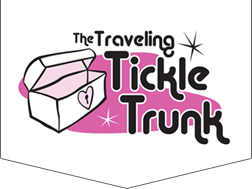When it Comes to Advertising Sex Products, All Things Are Not Equal

Advertising is sneaky because it utilizes subtle hints to [not so] gently push us to buy or do things. A lot of the time we aren’t even fully aware of the ads we see and how they affect our decisions. Take a second to think about it, how many formal advertisements have you seen for sex toy stores or other sexual wellness products/services? Very few unless it’s viagra right? This lack of visibility is also subtle and sneaky because we don’t actively think about what we are NOT being shown ads for and it speaks volumes about what products and services are deemed “acceptable”, “important”, and worth promoting in our society.
There are many barriers one faces when trying to share their work in the sexuality field on top of the challenges any other business may face. Brenda has experienced this, especially in the earlier years of the Tickle Trunk with certain sentences and images not being approved for advertising. I have also experienced this in my own work, mainly through covert censorship on instagram. These challenges are magnified when intersections of race, disability, sexuality, and gender are also applied, especially in comparison to the challenges similar companies run by men face (very very few).
I am neither being dramatic or exaggerating, there are countless examples of advertisements created by and for women-run sexuality companies that have been denied while their white, cis male-run counterparts have been accepted. Perhaps the most noteworthy as of late, is the ongoing legal fight between woman-run sex toy company Dame and the New York Metropolitan Transit Authority.
In 2018, Dame attempted to advertise their products on the subway, a great idea to increase brand visibility. The company reportedly spent $150,000 revising their ad campaign to align with the MTA regulations, only to have their ads rejected months later. Dame’s ads were pictures of their discrete, colourful sex toys with punny, transit-related slogans such as “91% of men get where they’re going while 60% of women…don’t”.
The transit authority said to have denied this campaign because they do not allow “sexually oriented businesses” to advertise on the subway because it is a transit system used by a diverse crowd of people. Where Dame took issue with this response is the inconsistency because many similar brands catered towards the sexual needs of people with penises have been allowed.
Shortly after this, Dame partnered with Unbound, a sexual wellness company who also had ads for their sex toys rejected, to demonstrate this inconsistency through a campaign titled “Approved, Not Approved”. As you may have gathered, Approved, Not Approved shows ads that have been rejected alongside similar ads that have been allowed to run. Among the ads that have been rejected are the campaigns from Dame, Unbound, period underwear brand Thinx, razor company Billie, and more. None of these ads showed sexually explicit images and were fairly vague.
Their examples of advertisements that were allowed to run include erectile dysfunction medication ads featuring pictures of naked people or phallic-shaped cacti, breast augmentation posters with topless women, and a number of other campaigns featuring sexual images and language, many of which were approved by the same transit authority who said they do not allow sexually oriented businesses to advertise.
You can check these ads out and learn more at approvednotapproved.com. A couple examples are pictured below.
So, what I gather from this, is that it is not always about WHAT is being advertised, it is more often about WHO is doing the advertising. This censorship is framed to be in the interest of the greater good, protecting people from potentially damaging content, but that’s clearly not what’s going on if ads for HIMS (erectile dysfunction pills) can be promoted but ads for HERS (the counterpart of HIMS, which sells birth control pills and more) are rejected. Often these decisions are made in favour of white, straight, cis male ideas of acceptability and are in line with how they see the world. What is so “potentially damaging” about advertisements directed towards the pleasure of people with vulvas?
The good news is that Dame finally had an advertisement accepted with the MTA in November 2021. Albeit, it is much more subtle and does not picture their products, but it is a win and I hope they are simultaneously able to make money off this opportunity and help improve the sexual wellness of many more people!
Advertising may seem arbitrary, but it is important to question what we are shown and what is hidden. Alexandra Fine, CEO and cofounder of Dame Products says, "Advertising is a necessary and important part of connecting people to valuable solutions," she says. "Not only that, but it sanctions certain lines of conversation."




